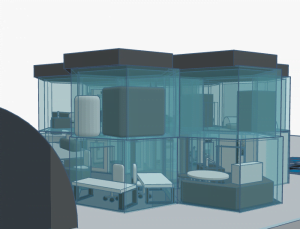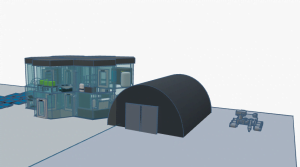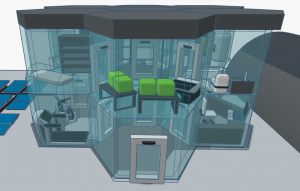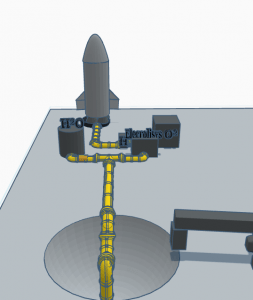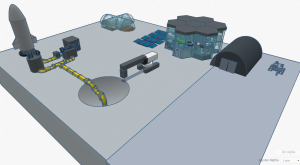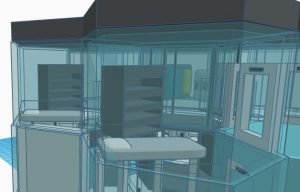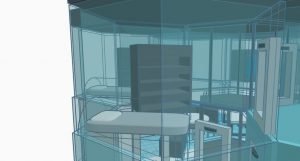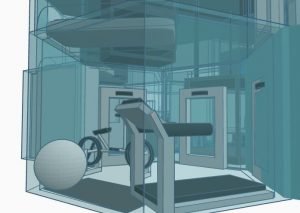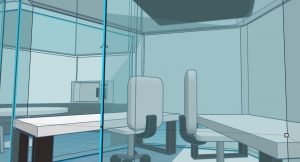Moon Camp Explorers Gallery 2020-2021
In Moon Camp Explorers each team’s mission is to 3D design a complete Moon Camp using Tinkercad. They also have to explain how they will use local resources, protect astronauts from the dangerous of space and describe the living and working facilities.
Team: I.E.S. LOS CASTILLOS
I.E.S. LOS CASTILLOS ALCORCÓN (MADRID) Spain 12, 13
External link for 3d
|
Project description
Our Moon Camp is an expandable base, designed to be enlarged as the crew increases or ecosystems in greenhouse grow up. Water is the critical resource for our human habitat, so the camp is settled next to a small crater where water ice exists because of permanent shadowed areas inside. Water ice will be extracted and transformed into liquid from these dark zones by a controlled sublimation process. The settlement is divided into different modules, each one with its own purpose, design and materials, these designs are based in three structures: First, a folding structure for the greenhouse, making it possible to change its dimensions mechanically to host different size ecosystems. Second, hexagonal shape habitats for the living quarters, warehouse, dining room or gym, where part of it is undergrounded to protect from micrometeorites. Third, rigid structures for the power module, shuttle platform or oxygen tanks. We consider the greenhouse as a core unit, a folding four semispheres structure, with different environments supplying oxygen and carbon dioxide through plants photosynthesis and food via aquaponics. Energy is obtained through solar panels distributed all along a big area on the camp surface, the space reserved to this objective is quite big because of the wide angle of incidence of sun rays with the surface, so that sun rays are little energetic and a lot of panels are necessary to produce a reasonable amount of energy. A recycling module helps astronauts to obtain water and nitrogen from their urine and feces. |
|||
|
Where do you want to build your Moon Camp?
Close to the Lunar Poles Why did you choose this location?
Our Moon Camp is settled at the north of Ibn Bajja crater, about 200 km from the south pole where temperatures are not so extreme because of the higher angle of incidence of sun rays. The ridge of Ibn Bajja is near-constantly illuminated, an advantage to light up the base and to place solar panels to power the equipment. In the same way, water ice concentrates at permanently shadowed areas at the bottoms inside the crater. The crater size, about 2000 m depth, is adequate to extract water ice from shadowed areas inside, transforming it into liquid water by controlated sublimation using pipelines. After the extraction, an electrolysis process is carried out in order to obtain oxygen for breathing and hydrogen as fuel for the shuttle. On the crater ridge, 450 m high, communications with Earth are adequate, no additional satellite is needed as on the dark side of the Moon.
How do you plan to build your Moon Camp? Which materials would you use?
To build up the camp, we send modular parts to be assembled in situ, building up the different structures. We have to use as little space as possible, in order to save energy to refrigerate spaces and to perform efficient pressurising. This is the reason why the main central structure, where living quarters, gym, dining rooms and other important rooms are located, is built adding up little modules with hexagone plants. This hexagonal form enables adding up other modules little by little as the crew grows and more people habits the camp, accommodating the astronauts and instruments inside. The material for these structures are interwoven layers of kevlar and mylar for the roof. The greenhouse is built with the Hoberman´s expanding system, so that the structure will expand as ecosystems inside grow up. To cover the outside of the greenhouse and the main building walls we use pneumatic panels made of ETFE (Ethylene tetrafluoroethylene) transparent and filled with water. Gravity on the Moon is one sixth gravity on Earth, so weight is not a critical problem for the structure stability. This greenhouse and main walls are protected by a double graphene layer, giving resistance to the structure.
Explain how your Moon Camp will provide the astronauts with:
|
|||
|
Water
|
Food
|
Electricity
|
Air
|
|
As already mentioned, we have decided to get the water ice from the bottoms inside the crater using a pipeline performing a controlled sublimation process. |
As aforementioned, a greenhouse module will be built, in order to cultivate food for the habitants of the base. The idea is to divide the crops into the different sections inside the greenhouse, according to the water they require for their growth. |
As a renewable energy source we will have the sunlight, which we will obtain thanks to the solar panels that we will place near the camp, to provide it with energy. |
Some porcentage of the water will be destined to the energy power plant, where it will be treated and through an electrolysis process it will be transformed to supply oxygen to the different habitats. |
|
Describe a day on the Moon for one of your Moon Camp astronauts
Organization is fundamental to keep the crew alive, so diary tasks related to control have to be organized to keep safe. First, it is necessary to control the pressure inside the habitats, if there is a loss of pressure because air comes out the habitats, people can die in minutes. Another important process to care for is electrolysis because this process generates oxygen complementing that coming from the plants in the greenhouse. About energy, although we can use batteries during a short period of time, solar panels are important to generate energy to power equipment and keep the pressure pumps running. The crew will be divided into shifts to control all the previous aspects, there will have to be a night shift so that someone is awake in case there is a failure or a problem in the system and it has to be repaired. Then, there will be the day shift in which each person will have a different job in different sections of the camp. Each shift will have breaks to eat and interact with other camp habitants in the common rooms, to relax or use the gym for example, without forgetting their sleep hours. |
|||


